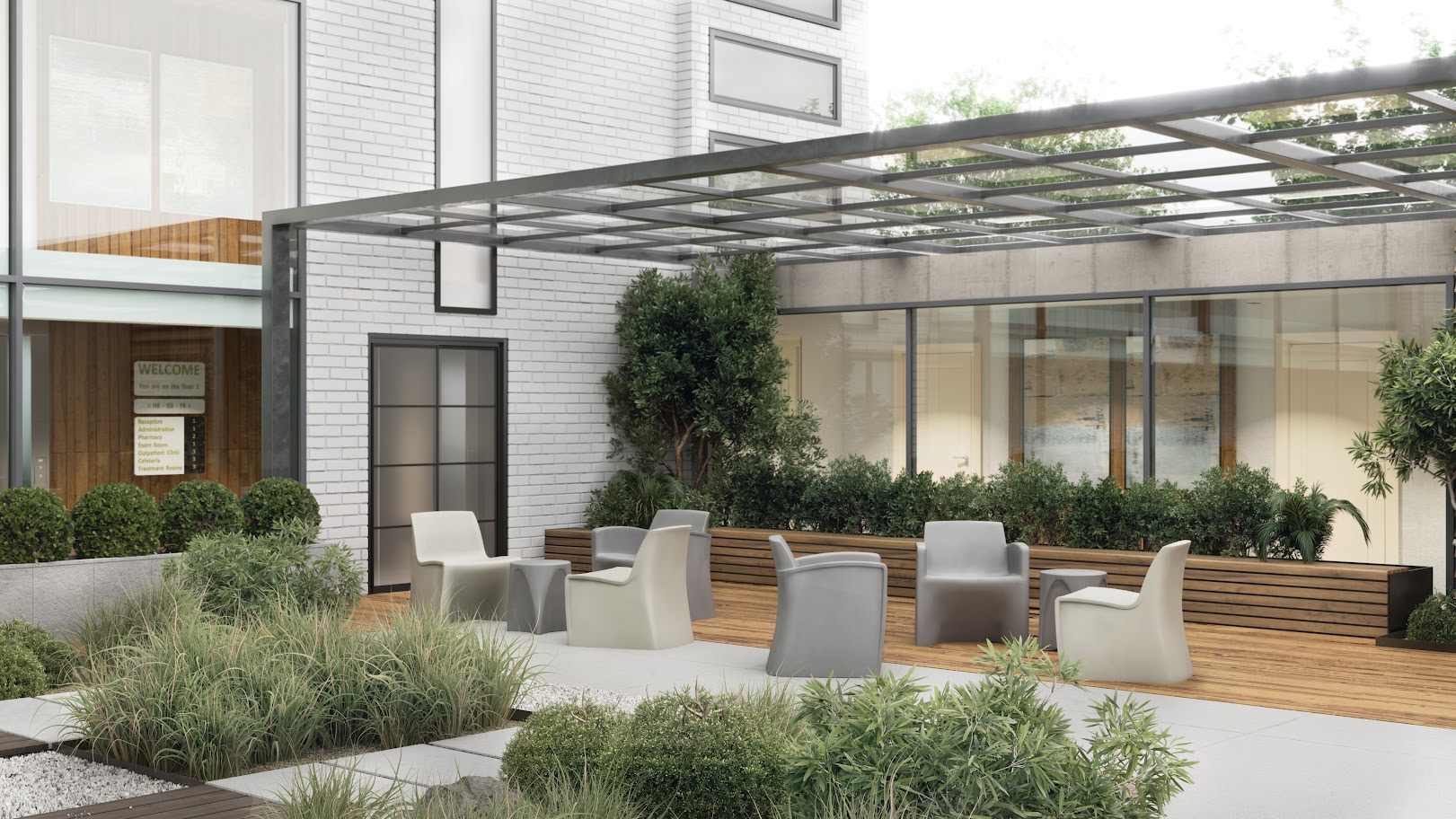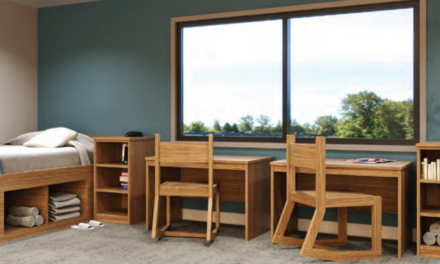Behavioral health interior design trends are all about feel-good functionality in 2023. Our design experts are focusing on creating spaces with characteristics that keep mental wellness a top priority for both patients and staff. Healthcare interior design must aid clinical staff in their workflows, lead to improved outcomes and create spaces for optimal patient wellbeing. Learn how to utilize behavioral health interior design trends to improve patient experiences and prevent staff burnout.
4 Behavioral Health Interior Design Considerations for Your Next Room Refresh Project
1. Create Calming Spaces for Mental Health Interior Design
Interior design and mental health go hand-in-hand. Together, both can help alleviate healthcare worker burnout and improve patient experiences. Here are some tips when designing, renovating, or reconstructing your healthcare facilities:



- Provide access to outdoor spaces – Incorporate natural light and integrate organic design elements that help support mental health. Through strategic healthcare facility design, you can help boost connectivity to the natural environment to benefit the health of everyone in the building. Add hardy plants to a popular window spot to bring the outdoors in and help with air purification.
- Insert a room with a kitchen-like feel – Consider designing a room with kitchen-like qualities where people can sit and enjoy hospitality. This can help to create a space that is familiar to individuals and provides a place to relax.
- Position admission rooms as “welcome rooms”– Staff and patients alike are affected by healthcare interior design. Designating spaces that are used as “welcome rooms” may help to alleviate stress and anxiety from the moment an individual enters the facility.
- Strategically position hallways to create ongoing soothing opportunities – Designing hallways to provide smooth transitions from place to place can help the space seem more open and welcoming. Avoid hallways with sharp turns or tight spaces, which can cause a space to feel cramped and small.
- Consider adding additional “bonus rooms” – Adding additional bonus rooms for patient and staff use can add to an overall positive atmosphere. Exercise rooms, art rooms, serenity rooms, and vibrating lounges are common trends in mental health interior design, allowing patients and staff the flexibility to relax and care for themselves when needed.
Partner with our behavioral health interior design and project management experts for a seamless space revamp.
2. Utilize Natural Colors & Purposeful Lighting in Mental Health Design
Another trend in behavioral health interior design consists of utilizing natural colors and purposeful lighting in healthcare facilities. These popular colors and lighting techniques support the holistic well-being of both patients and staff alike.
- Using nature-inspired hues – Blues, greens, browns and golds, provide the perfect complement to your healthcare interior design. Infusing these colors in your healthcare environment can be done through refresh in furnishings and paint colors. In addition to nature-inspired hues, purple is becoming a commonly used color for its soothing qualities.
- Lighting – Add dimming capabilities to your lighting system for a more subtle lighting appearance. Having the ability to dim the lights gives individuals choice and comfort, helping with overall relaxation.
Looking for more behavioral health design trends? Our room-by-room behavior health design guide can help you create welcoming spaces for your patients and staff.

3. Create Home-like Spaces Using Mental Health Interior Design
Another aspect to consider is furnishings. How you furnish and style your healthcare space can help change the atmosphere for both patients, family members and staff. Here are some current trends for furniture in healthcare interior design:

- Rocking Chairs and Gliders – Rocking chairs and gliders are a great way for individuals to feel calm and peaceful. Having the ability to move while seated provides a sense of comfort as opposed to stiff, stationary chairs.
- Artwork – adding artwork to a space brightens up the area, giving individuals something to focus on and adding to an overall welcoming and home-like atmosphere. Paintings, pictures, and other unique decorative pieces can help the individual feel comfortable in the provided space.
- Sofas and lounge seating – Add furniture that you would use in your home environment, such as sofas and other lounge seating. This creates a familiar and welcoming environment for individuals entering the facility. Consider products such as the BH Three Seat Chair which are highly durable and comfortable.
Need help choosing the right furnishings for behavioral health interior design? With our free consultations and over 200+ furnishings to select from, a room refresh has never been easier.
4. Prioritize Safety in Mental Health Facilities
Safety is of utmost importance in healthcare. Here are some ideas to keep in mind when choosing furniture that will ensure the safety of your patients and staff:
- Rounded tables – Adding rounded tables to your healthcare facility can add to the fluid nature of the space. They are safe and prevent individuals from harming themselves by sharp corners, while also adding an elegant feel to the room.
- Resident room desks, chests, wardrobes and shelving – Examine the type of furniture you are adding to resident rooms as well. Ensure that they are not only durable but are also safe for the patient and staff. Review your interior design plan and choose casegoods that help to create a comfortable and welcoming environment.

In addition to furnishings, make sure you have the ability to provide choice to your patients. Ask them, “Would you like to sit on the sofa or at the table?” Giving your patients choice helps them know they are valued at your facility.
Healthcare Worker Burnout Solutions
In this health climate and staffing shortage, we are asking a lot of our clinical and nursing care staff. Many of the same holistic well-being healthcare design trends mentioned above can be applied to staff spaces as well, including fostering a connection to the outdoors, inserting kitchen-like rooms, and using nature-inspired hues to aid emotional exhaustion.
- Tip! How to prevent burnout in healthcare: when designing a staff respite space, add a recliner or sleeper sofa in addition to traditional tables and chairs. Provide ample charging ports for personal electronics so staff can connect with family and friends during their breaks.
Another staff and patient experience best practice leverages infection prevention. Many providers are rethinking the way staff members enter the building as well to promote infection prevention. If the staff entrance leads into a shared patient space, providers may want to create a separate entry for staff. A separate area can allow employees to clean up before and after their shifts.

The Bottom Line: 4 Behavioral Health Interior Design Considerations
When designing spaces for behavioral health, leveraging these trends to enhance mental health can help you create a more marketable, attractive space. Alleviate healthcare worker burnout and elevate patient wellbeing by infusing interior design and mental health.
Our project services team can help interior design and mental health coincide in your healthcare setting with paint and furnishing selection, delivery and installation, and project management. With over 12,000 projects completed every year, our design experts can aid you in alleviating burnout and creating optimal patient experiences.
Looking to revamp a behavioral health space?
Request a free consultation to start your next behavioral health design project and see why 50,000 Healthcare professionals count on Direct Supply.
Learn how our team can help outfit your behavioral health facility or explore room-by-room offerings.
Are you an interior designer?
See how we can help with your Healthcare design projects.




